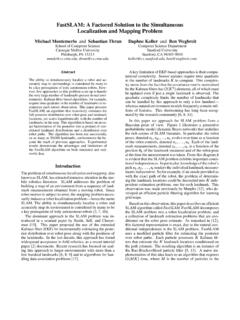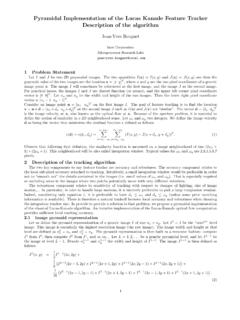Transcription of Robotic Mapping: A Survey - Sebastian Thrun
1 Robotic mapping : A SurveySebastian ThrunFebruary 2002 CMU-CS-02-111 School of Computer ScienceCarnegie Mellon UniversityPittsburgh, PA 15213 AbstractThis article provides a comprehensive introduction into the field of Robotic mapping , with a focus on indoormapping. It describes and compares various probabilistic techniques, as they are presently being appliedto a vast array of mobile robot mapping problems. The history of Robotic mapping is also described, alongwith an extensive list of open research research is sponsored by by DARPA s MARS Program (Contract number N66001-01-C-6018) and the National ScienceFoundation (CAREER grant number IIS-9876136 and regular grant number IIS-9877033), all of which is gratefully views and conclusions contained in this document are those of the author and should not be interpreted as necessarily repre-senting official policies or endorsements, either expressed or implied, of the United States Government or any of the.
2 Bayes filters, Robotic mapping , exploration, expectation maximization algorithm, Kalmanfilters, mobile robots1 IntroductionRobotic mapping has been a highly active research area in robotics and AI for at least two decades. Roboticmapping addresses the problem of acquiring spatial models of physical environments through mobile mapping problem is generally regarded as one of the most important problems in the pursuit of buildingtruly autonomous mobile robots. Despite significant progress in this area, it still poses great challenges. Atpresent, we have robust methods for mapping environments that are static, structured, and of limited unstructured, dynamic, or large-scale environments remains largely an open research article attempts to provide a comprehensive overview of the state of the art in Robotic mapping , witha focus on indoor environments.
3 Virtually all state-of-the-art Robotic mapping algorithms are algorithms are incremental, and hence can be run in real time, whereas others require multiple passesthrough the data. Some algorithms require exact pose information to build a map, whereas others can do sousing odometry measurements. Some algorithms are equipped to handle correspondence problems betweendata recorded at different points in time, whereas others require features to carry signatures that makes themuniquely writing this article, we tried to keep the level of mathematics at a minimum, focusing instead onthe intuition behind the different techniques. However, some mathematical notation was deemed necessaryto communicate the basic concepts in a crisp way. The serious reader is invited to read some of the articlesreferenced in this paper, which discuss many of the ideas presented here in more Historical OverviewWe begin with a brief overview of the history of Robotic mapping .
4 The reader not interested in the historicalperspective is encouraged to skip this mapping research has a long history. In the 1980s and early 1990s, the field of mapping waswidely divided into metric and topological approaches. Metric maps capture the geometric properties of theenvironment, whereas topological maps describe the connectivity of different places. An early representativeof the former approach was Elfes and Moravec s importantoccupancy grid mapping algorithm[31, 32, 69],which represents maps by fine-grained grids that model the occupied and free space of the approach has been used in a great number of Robotic systems, such as [8, 9, 10, 42, 83, 98, 106,107]. An alternative metric mapping algorithm was proposed by Chatila and Laumond [15], using sets ofpolyhedra to describe the geometry of environments.
5 Examples of topological approaches include the workby Matari c [62], Kuipers [53] and many others [17, 18, 34, 52, 76, 87, 86, 102, 105, 108]. Topological mapsrepresent environments as a list of significant places that are connected via arcs. Arcs are usually annotatedwith information on how to navigate from one place to another. However, the distinction between metricand topological has always been fuzzy, since virtually all working topological approaches rely on geometricinformation. In practice, metric maps are finer grained than topological ones. Higher resolution comesat a computational price, but it helps to solve various hard problems, such as the correspondence problemdiscussed further , a second taxonomy of mapping algorithms isworld-centricversus robot -centric.
6 World-centric maps are represented in a global coordinate space. The entities in the map do not carry informationabout the sensor measurements that led to their discovery. robot -centric maps, in contrast, are described inmeasurement space. They describe the sensor measurements a robot would receive at different locations. Atfirst glance, robot -centric maps might appear easier to build, since no translation of robot measurementsinto world coordinates are needed. However, robot -centric maps suffer two disadvantages. First, it is oftendifficult to extrapolate from individual measurements to measurements at nearby, unexplored places an1extrapolation that is typically straightforward in world-centric approaches. Put differently, there is usuallyno obvious geometry in measurement space that would allow for such extrapolation.
7 Second, if differentplaces look alike, robot -centric approaches often face difficulties to disambiguate them, again due to the lackof an obvious geometry in measurement space. For these reasons, the dominant approaches to date generateworld-centric the 1990s, the field of robot mapping has been dominated by probabilistic techniques. A seriesof seminal papers by Smith, Self, and Cheeseman [91, 92] introduced a powerful statistical framework forsimultaneously solving the mapping problem and the induced problem of localizing the robot relative to itsgrowing map. Since then, Robotic mapping has commonly been referred to asSLAMorCML, which is shortforsimultaneous localization and mapping [25, 30], andconcurrent mapping and localization[56, 101],respectively. One family of probabilistic approaches employ Kalman filters to estimate the map and therobot location [14, 20, 27, 38, 55, 73, 104].
8 The resulting maps usually describe the location of landmarks,or significant features in the environment, although recent extensions exist that represent environments bylarge numbers of raw range measurements [60]. An alternative family of algorithms [23, 86, 87, 97, 101]is based on Dempster sexpectation maximizationalgorithm [24, 65]. These approaches specifically addressthecorrespondence problemin mapping , which is the problem of determining whether sensor measurementrecorded at different points in time correspond to the same physical entity in the real world. A third familyof probabilistic techniques seek to identifyobjectsin the environment, which may correspond to ceilings,walls [44, 58, 61], doors that might be open or closed [2], of furniture and other objects that move [6,83].
9 Many of these technique have counterparts in the computer vision and photogrammetry literature -aconnection that is still somewhat underexploited [1, 3, 5, 16, 21, 43, 88]. robot exploration in the context of mapping has also been studied extensively. Today s approachesare usually greedy, that is, they chose control by greedily maximizing information gain [12, 17, 89, 105],sometimes under consideration of safety constraints [37]. However, the topic of robot exploration is beyondthe scope of this article, hence will not be addressed any The Robotic mapping ProblemThe problem of Robotic mapping is that of acquiring a spatial model of a robot s environment. Maps arecommonly used for robot navigation ( , localization) [7, 51]. To acquire a map, robots must possesssensors that enable it to perceive the outside world.
10 Sensors commonly brought to bear for this task in-clude cameras, range finders using sonar, laser, and infrared technology, radar, tactile sensors, compasses,and GPS. However, all these sensors are subject to errors, often referred to as measurement noise. Moreimportantly, most robot sensors are subject to strict range limitations. For example, light and sound cannotpenetrate walls. These range limitations makes it necessary for a robot to navigate through its environmentwhen building a map. The motion commands (controls) issued during environment exploration carry im-portant information for building maps, since they convey information about the locations at which differentsensor measurements were taken. robot motion is also subject to errors, and the controls alone are thereforeinsufficient to determine a robot s pose (location and orientation) relative to its key challenge in Robotic mapping arises from the nature of the measurement noise.















